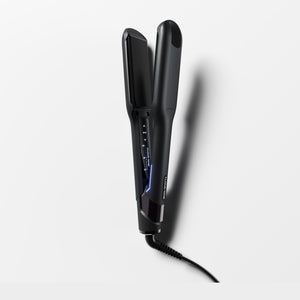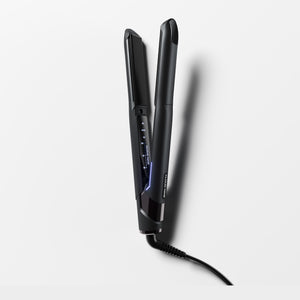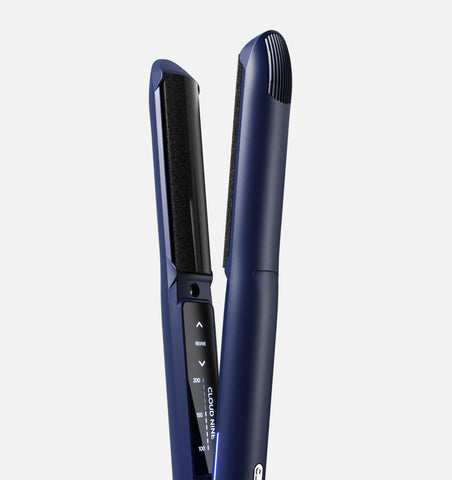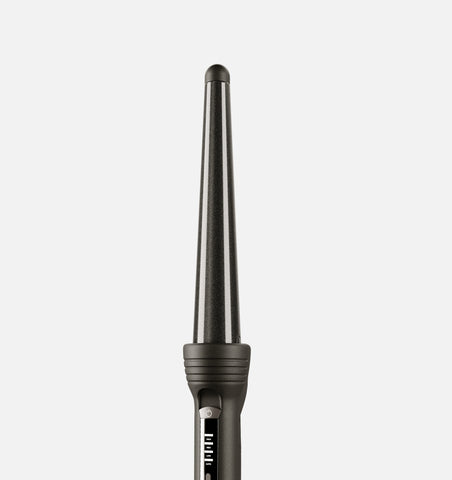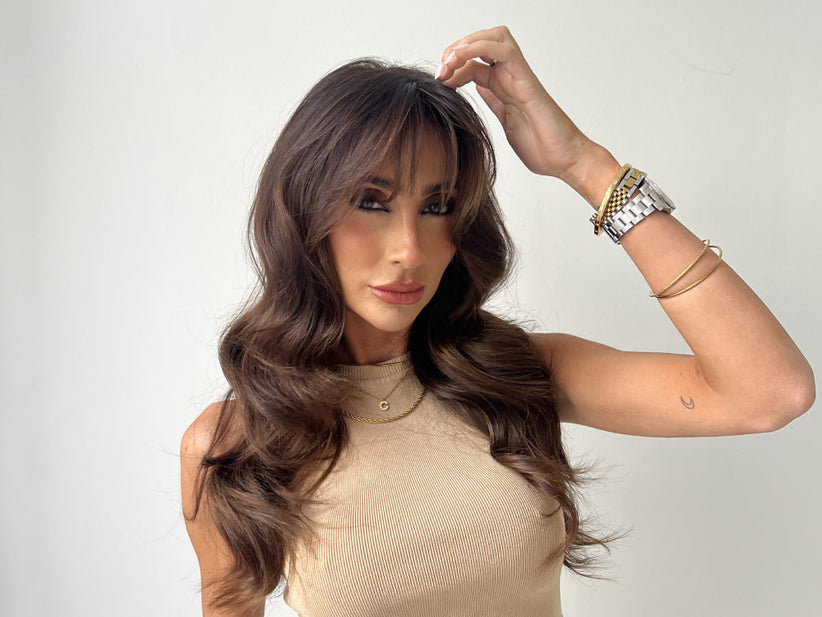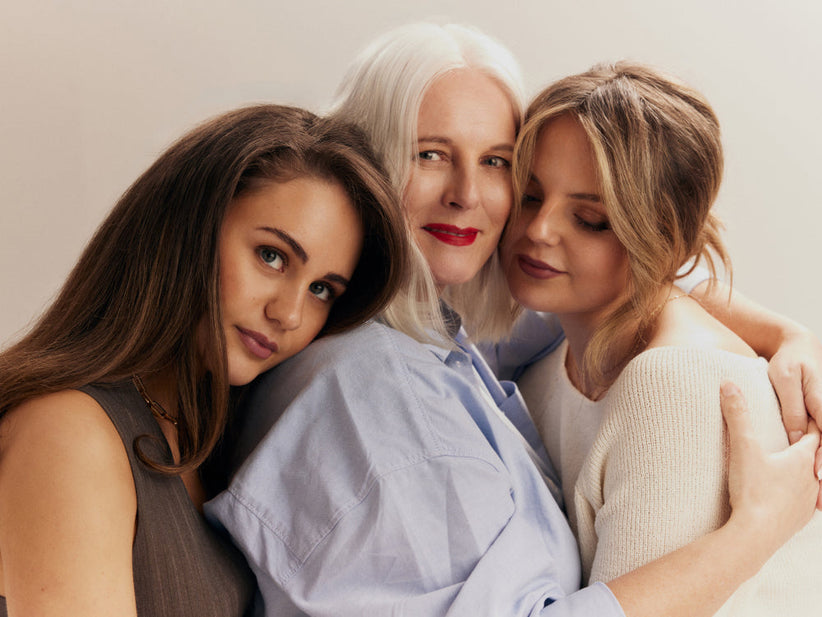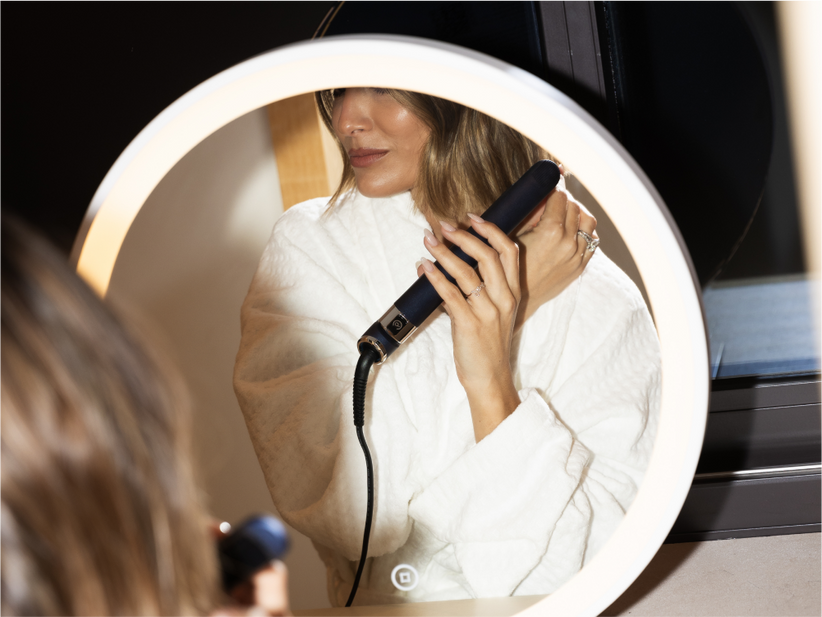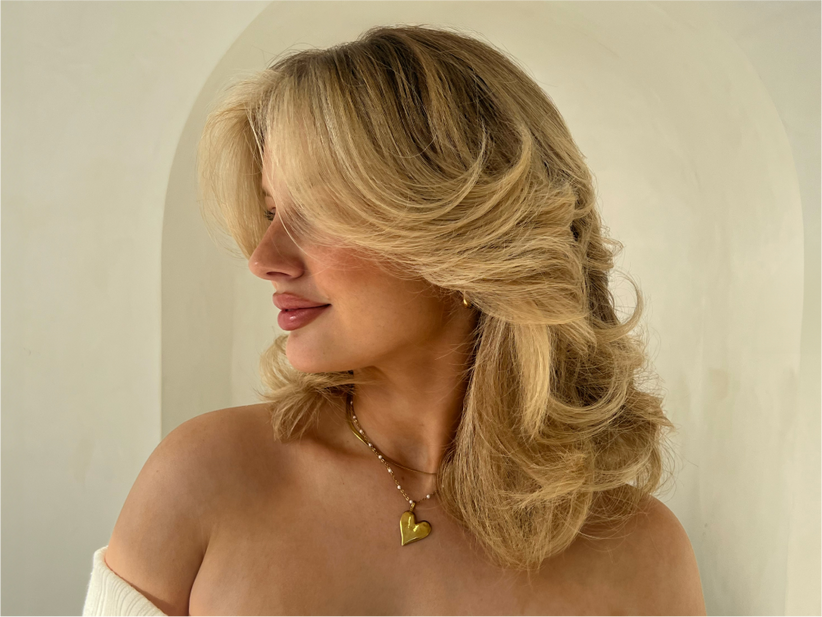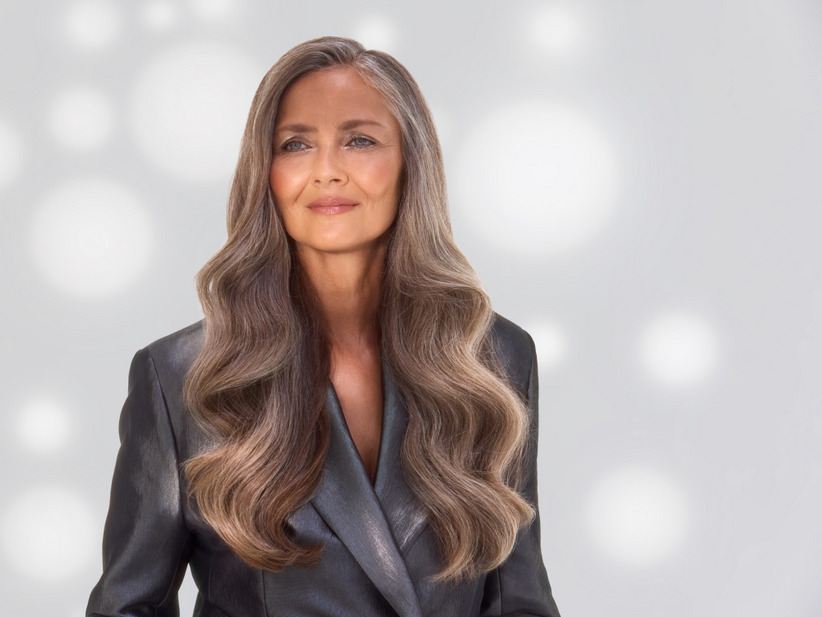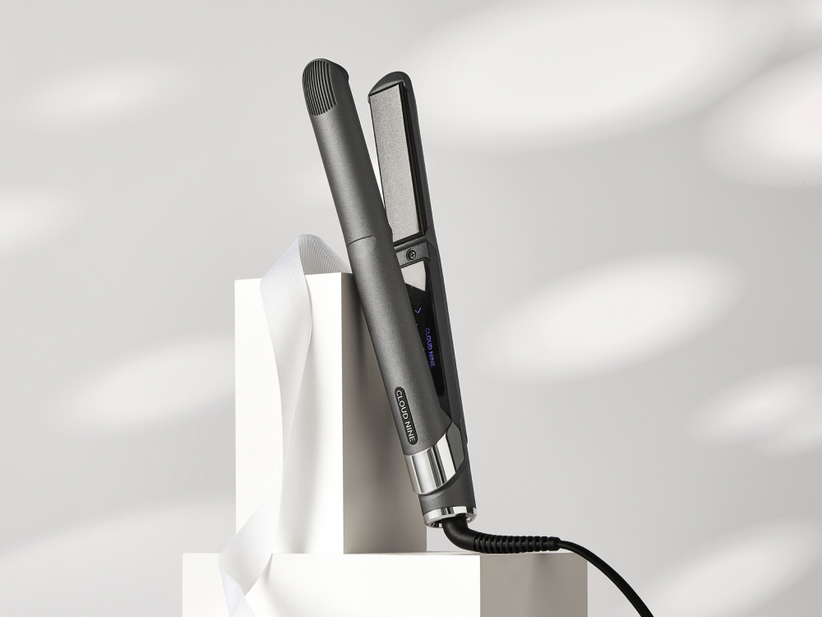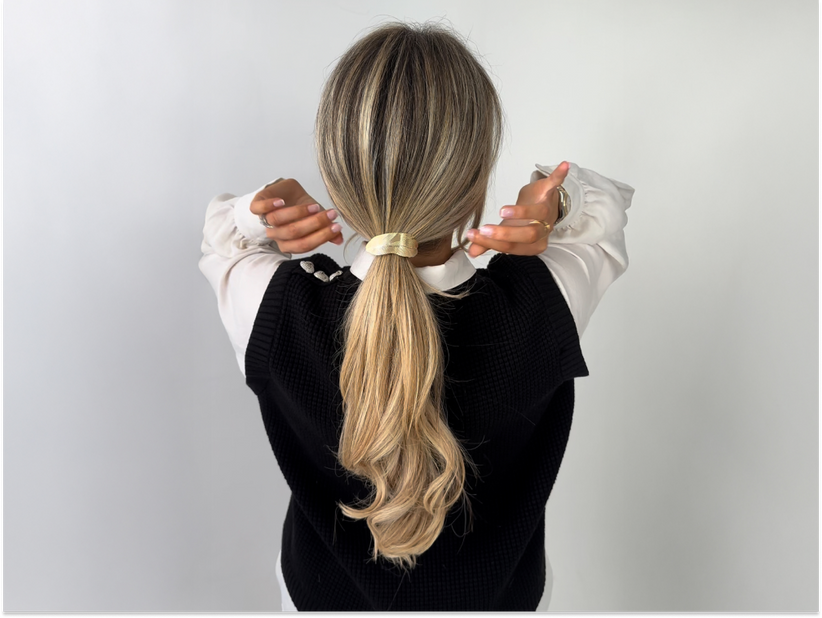We’ve said it before and we’ll say it again: your hair is as unique as you are. When it comes to crafting the perfect hair regimen, a bespoke approach is best. That’s why we’ve put together this handy guide that takes you through the best routines, ingredients, products, treatments and practices for each hair type, texture and concern. Healthy, vibrant hair? We’re coming for you.
BUILDING A HAIRCARE ROUTINE AROUND YOUR HAIR TYPE
If you’re not sure of your exact hair type, we’ve produced a handy guide. You can also head over to our Temperature Calculator and take the quiz before reading on. Not only will it tell you the perfect temperature for heat styling your hair, but it also reveals insights into your hair’s type, pattern and condition.
Type 1 / Straight Hair
Type 1 hair is characterised by its signature straightness. While others may straighten their hair as a part of their daily routine, you can be smug about your natural sleekness.
As well as its straightness, your hair is also more prone to oil build-up and flatness due to its fine texture. As a result, a haircare routine that relies on minimal, lightweight product application is best to avoid a greasy scalp and weighed-down strands. Reach for products that add volume and texture without weight, such as volumizing shampoos and conditioners.
When it comes to heat styling, Revive Mode™ is your best friend. This innovative CLOUD NINE feature reduces the amount of time your hair is under direct heat contact, helping to keep your hair as healthy as possible. Try adding some curl to your type 1 hair with the CLOUD NINE 2-in-1 Contouring Iron Pro. It also comes with a wet hairbrush and a detangle comb, which give you more options for type 1 haircare.
Type 2 / Wavy Hair
Caring for type 2 hair is all about riding the waves. Your hair is made up of loose, stretched waves that give you that beachy look with no effort.
While your waves are gorgeous, they’re also slightly prone to frizz and can lie a little uneven, with some parts of your hair being wavier than others. Luckily, your hair is unlikely to suffer from either excess oil or excess dryness. However, it probably sits flatter on the top of your head, lacking volume at the roots compared to curlier hair types.
Your type 2 hair benefits from regular washing with a clarifying shampoo to remove product build-up where the hair sits flat against the scalp. Follow up with a conditioner to prevent dryness. Stick with lightweight and volumizing product formulas to avoid weighing down your natural waves, which can stretch them out to straight.
As with all hair types, if you’re applying heat to your type 2 hair, don’t forget to spritz Magical Potion first for adequate heat protection.
Type 3 / Curly Hair
You’re blessed with bouncing, high-volume spiralling curls. They’re big in size and big in impact – but they take some care to maintain. Your two main haircare and styling goals are likely to be curl definition and moisture retention.
To define your curls, try stronger hold styling products like curl creams and gels, which are ideal for taming any signs of frizz.
Talking of frizz, moisture is your friend. Incorporate CLOUD NINE Magical Remedy into your haircare routine to deeply condition for bouncy and hydrated curls all day long. If you like to use heated tools, this miracle product also provides heat protection so you can style with confidence.
Protect your curls while you sleep by resting your head on a silk pillowcase. This little luxury helps to protect your type 3 hair from heat, friction and humidity, keeping it in the best condition.
For more tips on how to style your type 3 hair to perfection, consult our curly hair guide.
Type 4 / Afro Hair
Type 4c hair is uniquely beautiful. Your tightly kinked curls aren’t that defined, but they’re springing with natural volume.
Moisture should be at the top of your haircare priority list. Your hair type is more susceptible to dryness and damage than others, so it craves moisture to keep it shiny, defined and healthy. Deep and leave-in conditioning products should be at the core of your haircare arsenal, as well as hydrating oils and serums, which can help to protect your hair from moisture loss.
Protective styles are your best friend. These shield your 4c hair from environmental elements like heat and humidity, with minimal manipulation and tightness, both of which can lead to scalp tension and strand damage.
For more detailed guidance on styling and caring for 4c hair, read our guide to managing and caring for type 4c hair.
BUILDING A HAIRCARE ROUTINE AROUND YOUR HAIR LENGTH
The length of your hair is a style choice, rather than something you’re born with, but it still has a huge impact on your hair care routine. Whether you’ve got curls down to your knees or you’ve gone for the chop, we’ve got the perfect hair care and styling tips for your hair length.
Long Hair
Congrats on growing your hair so long – that’s half the challenge. Now you’re looking for a haircare routine that helps you keep all that luscious length healthy and shiny. Try these tips:
Book in for regular trims
Just because you’re all about length, doesn’t mean you should be skipping the hairdresser. Long hair needs regular trims as the longer the hair gets, the older it gets, and can become dull and dry through the lengths as it grows further away from the scalp’s natural oils. A little trim can remove split ends, preventing them from developing into further damage, and give your long hair the refresh it needs to thrive.
Detangle gently
We don’t need to tell you that long hair is more prone to tangling. From windy weather to working out, the world throws a lot at long hair and can leave it in knots. In addition to daily brushing, our best tip for gentle and effective detangling is to hop in the shower, wash as usual, then apply a deep conditioning treatment and take the time to slowly and gently disperse it with a wide-toothed comb before rinsing. Do this each time you wash your hair.
Schedule a scalp detox
You likely use hair products to help tame your long hair. Those, in addition to your hair’s natural oils, can create a build-up that leaves the scalp struggling to breathe. Give it a refresh with the help of a scalp detox. Learn how with CLOUD NINE’s 9-Day Detox.
Short Hair
So you’ve braved the snip and gone for an edgy, short look. We love it! Now it’s time to switch up your haircare routine to offer your new, cropped style the treatment it needs.
Avoid over-brushing
Your short hair is much less likely to become tangled than longer hair, so you can give your hairbrush a break. Overbrushing can risk damage to the hair and stress to the follicles, resulting in problems like dandruff and excess oil production. Your short style is so low-maintenance, that you can sometimes get away with just running your fingers through it to restore volume and shape.
Use minimal product
With less hair to style, you’ll need less product to hold it. When it comes to short hair especially, using excessive product can weigh down the strands and give your hair a greasy, dirty look. Less is more.
Choose a tool that’s made for shorter lengths
Have you ever tried styling a pixie cut with a wide-barrel curling wand? We don’t recommend it. Instead, invest in a heated styling tool that’s designed for shorter hair. CLOUD NINE’s Slim Iron is perfect for the job – its half-inch plates are ideal for precision styling. Prefer to curl? Try our Texture Wand, with a tapered barrel for customised curling on all hair lengths.
BUILDING A HAIRCARE ROUTINE AROUND YOUR ETHNICITY
While people of the same ethnicity don’t necessarily all have the same hair type, many ethnic groups share defined hair characteristics. As a result, some cultures have developed routines and rituals around hair care, suited to their specific needs.
Indian Hair
People from the Indian subcontinent often have very thick hair, which can be curly, wavy, or straight. Hair oils and serums that contain ingredients such as argan, coconut, and almond oils can give Indian hair a great shine boost and help to make its thick texture more manageable. Castor oil is another common ingredient in Indian hair care thanks to its moisturising properties and ability to promote hair growth by increasing blood flow when combined with head massage techniques.
Black or Afro Hair
Black or Afro Hair usually falls under type 4. It can be very dense and tightly curled or coiled and relies on a lot of moisture to stay healthy.
Thicker, more nourishing moisturising products often form the basis of African or Afro-Caribbean haircare routines. In addition to washing the hair less frequently to avoid drying it out, Afro hair benefits from regular treatments of oils, curl creams and leave-in conditioners. Some may even use the LOC method, which stands for liquid, oil, cream and involves applying moisturising products of each consistency in that order to maximise hydration.
East Asian Hair
East Asian hair is often thick but is also characterised by lower density, which can make it appear finer and less voluminous. It also tends to be straight and silky, without any wave or curl.
It’s best to avoid thicker conditioning products and heavy oils when it comes to moisturising and styling East Asian hair. Instead, opt for lightweight conditioners to avoid a greasy look. One popular cultural hair treatment in East Asia is the application of aloe vera to the hair for its anti-bacterial and anti-oxidant properties.
BUILDING A HAIRCARE ROUTINE AROUND YOUR HAIR POROSITY
Porosity is a measure of the hair’s ability to hold onto water. Your hair’s natural porosity is determined by your genetics, but heat and chemical treatments can alter it. Hair porosity and pattern are two different things. Curly, wavy and straight hair can all have different levels of porosity, and different sections of hair on the same head can also vary in porosity.
Low-Porosity Hair
Low-porosity hair struggles to absorb and retain moisture. This can leave it feeling dry and rough, and make it difficult to hydrate.
To maximise your low-porosity hair’s ability to absorb the moisture it needs, you could try:
- Washing with a clarifying shampoo – This helps to reduce product build-up that lies on the scalp when hair does not absorb it, freeing up your follicles.
- Applying easy-absorb moisturisers – Lighter oils and liquid conditioners are easier for hair to absorb, even at low porosities.
- Heated conditioning treatments – Using a heated cap, thermal dryer or steam treatment while conditioning can help conditioning products penetrate the shaft of low-porosity hair.
High-Porosity Hair
High porosity hair is eager to absorb moisture but can lose it just as easily. That’s why it’s important to make regular moisture treatments a part of your routine if your hair is highly porous, to prevent it from becoming susceptible to breakage.
You may also benefit from:
- Gentle cleansing – Regular shampoos may be too harsh on your high-porosity hair, stripping them of their moisture. Instead, opt for something gentle and nourishing that is enriched with oils.
- Protein treatments – Protein-containing treatments and hair masks can help to repair and protect your hair shafts by minimising gaps in the cuticle.
- Sealing techniques – Once you’ve successfully moisturised your high-porosity hair, you want to keep that moisture in. One way to do this is through sealing techniques such as using a heavier product like an oil or cream to seal in hydration.
BUILDING A HAIRCARE ROUTINE AROUND YOUR HAIR THICKNESS AND DENSITY
As with porosity, your hair’s thickness and density don’t necessarily correlate to its curl pattern. If, for example, your hair is type 3, it could be any combination of thickness and density.
Thickness
When thick hair becomes tangled, it can feel impossible to detangle again. Prevent this from happening by investing in heavy-duty moisturising products that keep thick hair manageable. Washing less often can also help to tame thick hair, as the scalp’s natural oils have a chance to spread down the strands to provide some much-needed moisture.
Fine hair, on the other hand, can easily become weighed down by heavy products, so benefits from lightweight conditioners instead.
Density
While thickness refers to the dimensions of each strand of your hair, density refers to the number of hairs growing from each square inch of your scalp. Those with low-density hair are advised to avoid heavy products and opt for volumising ones instead, while those with high-density hair may benefit from heavier products to tame their strands.
The way your hair is cut can also be a help with managing hair density. Certain layered styles can help to disperse the hair in a way that gives the illusion of more volume, or that thins out very dense hair.
BUILDING A HAIRCARE ROUTINE AROUND YOUR HAIR ELASTICITY
Hair elasticity describes how much your hair can stretch before it breaks, and is an indicator of hair health. Strong elasticity indicates healthy, hydrated hair. Weak elasticity indicates that your hair needs moisture and proteins.
You know the drill by now. If your hair is lacking in elasticity, spend some time applying a moisturising, protein-rich mask to help it repair and strengthen.
BUILDING A HAIRCARE ROUTINE AROUND YOUR HAIR COLOUR
Hair colour, whether natural or artificial, is a big source of pride and identity for many. Keep yours fresh using our tips.
Naturally Light Hair
Naturally blonde or light-coloured hair is more susceptible to damage from UV rays, as it lacks pigment. To keep yours healthy, consider investing in a hair sunscreen to protect it. Natural blondes may also be more prone to dryness caused by the sun, so moisturising treatments are a must.
Naturally Dark Hair
Naturally dark hair does not necessarily come with any specific care requirements. The colour itself is fairly low maintenance. To keep your natural dark or brown hair looking its best, craft a routine around your hair type, thickness, density and porosity instead.
Bleached Hair
Bleached hair is much more fragile and prone to breakage than it was in its natural state. It has an intense need for moisture and is very porous. Bond-builders and intensive moisturising masks can help bleached hair spring back into shape. Follow our tips for dry and porous hair to get your bleached style back to its thriving self. Turn the dial down on your styling tools to avoid further damage.
Colour-Treated Hair
To keep your coloured hair looking as fresh as the day you stepped out of the salon, minimise washing and use a colour-maintaining shampoo. This will preserve vibrancy by helping to keep the pigment inside your hair. Moisturisation can also help with this, so consider applying the occasional mask or treatment. When heat styling, keep the temperature low to preserve your colour for longer.
Try our Temperature Calculator to discover everything you need to know about your hair type and how to treat it.
BUILDING A HAIRCARE ROUTINE AROUND YOUR HAIR CONCERNS
Hair is at the heart of our confidence. When it doesn’t feel right, we don’t feel good. Hair concerns are really common, so don’t feel alone if yours are bothering you. Take our tips to tackle these ordinary hair hiccups.
Damaged Hair
Hair damage happens to the best of us. Whether it’s getting a little trigger-happy on the temperature button or ripping a brush through your hair in a rush, it’s easy to mistreat our hair without thinking.
Fortunately, there are lots of solutions for hair damage, and the main one is free: TLC. Start treating your hair with kindness, and it will soon repair. This includes handling it gently, turning the temperature to the right setting, and using the occasional repairing and moisturising treatment, such as one containing proteins. Read our guide about how to reduce and avoid heat-damaged hair.
Dandruff
Dandruff can be uncomfortable and even embarrassing, but thankfully, it’s easy to treat. Banish any signs of a dry, itchy, flaky or oily scalp with the help of a medicated shampoo. These can be purchased both in the haircare aisle or from a pharmacy. Look for products that contain zinc pyrithione, salicylic acid, coal tar, selenium sulphide or ketoconazole for best results.
Dry Hair
All hair needs a certain amount of moisture, and if it doesn’t get it, it can begin to look dull, feel dry and straw-like, and be more prone to breakage. Make sure to incorporate hydrating treatments that are suited to your hair type, texture, density and porosity into your haircare routine. This includes shampoos, conditioners, leave-in treatments, oils, serums, and masks.
Frizzy Hair
If you have curly or wavy hair, you probably battle frizz at least sometimes. Addressing the cause of your frizz is the best way to combat it, so be sure to figure this out before trying any solutions. From anti-frizz serums and creams to smoothing masks, there are plenty of products out there – but it pays to do your research beforehand to avoid wasting your money on something that may not work for your hair. Check out our guide to frizzy hair.
Flat hair
One of the most common problems those with fine hair encounter is a chronic lack of volume, leaving the hair looking flat and a bit meh. It can be tempting to layer on the mousse and hairspray in an attempt to sculpt the hair into something bigger, but that’s not the best approach. Instead, focus on avoiding product build-up with lightweight, volumizing products and root-lifting techniques such as heated rollers. Discover more with our volumising tips.
Oily Hair
An oily scalp can be annoying and leave you feeling like your styling options are limited. Rebalancing your sebum production is the key to getting your hair back to its normal, clean-feeling self. Clarifying shampoos and lightweight conditioners can help. It’s also a good idea to experiment with your hair-washing schedule, as that greasy feeling could be a result of over or under-washing.
Thin / Thinning Hair
If your hair is thin or thinning, you may be looking for ways to make it look and feel thicker and more voluminous. Styling hacks like lightweight volumising products, root-lift rollers, braiding and teasing are all great ways to give the illusion of volume – just be sure to handle your thin hair with care to avoid damaging it.
Hair Fall
Some hair fall is normal for everyone. In fact, losing 50 to 100 hairs daily is entirely average, so if you notice some hair in the shower drain or on your comb or brush, it’s not a problem.
If you feel you’re losing more hair than usual and are worried about hair loss, there are a range of causes that might be responsible. Consult our guides to:
- Nutrition and Hair Loss
- Menopausal Hair Loss
- Hormonal Hair Loss
- How Hormones Affect Your Hair
- Seasonal Shedding
YOUR STEP-BY-STEP HAIR ROUTINE
Now you’ve learnt all about the different requirements of hair types and conditions, customise this template to craft your perfect haircare routine with the right tips for you.
1. Exfoliate
Removing scalp build-up provides an essential refresh and a clean base for new product application. Use a specialised scalp scrub, or a handheld massage tool while shampooing to gently exfoliate your scalp. See our Scalp Care Rituals blog to learn more.
2. Wash / Cleanse
Use a shampoo that’s suited to your requirements to cleanse and clarify the hair, as often as suits your hair type. This removes build-up and impurities and leaves your hair ready to absorb the next step: a conditioning treatment.
3. Condition / Nourish
All hair requires conditioning to stay strong, healthy and shiny. Apply daily conditioners, leave-in conditioners and deep conditioners as required by your hair type.
4. Treat
If your hair requires a little more care than usual, now’s the time to do it. Detangling, protein and deep moisturising treatments are all perfect for applying to washed and conditioned hair.
5. Dry
Whether you choose to blow-dry or let your hair dry naturally, take care. Hair is at its most fragile when wet, so don’t handle it too roughly if leaving it to air dry. For blow-drying, make sure to apply Magical Potion for heat protection.
6. Style / Protect
Apply the right styling products for your hair. From oils and serums to mousses and sprays, there’s something out there for every style and requirement, whether smoothing, volumizing or defining. Don’t forget to protect your hair from heat with Magical Potion before using your straighteners or curlers. If wearing the hair up, opt for loose styles to limit scalp tension.
HAIR ROUTINE FAQs
Still got questions about your haircare routine? Let us explain.
Should I wash my hair every day?
Everyone’s hair is different and requires different frequencies of washing. That being said, washing your hair every day is probably excessive, and could even irritate your scalp and lead to avoidable dryness. Try washing your hair once every two-three days instead if it’s straight or wavy, and just once a week if it’s curly or coily.
How often should I cut my hair?
Regular haircuts are best for maintaining hair health. Trimming removes split ends and prevents further damage. For short hair, a trim once every four-six weeks is recommended to maintain your style, while medium-length hair should be cut every four-six weeks. If your hair is on the long side, book in for a trim at least every eight weeks.
Should I wash my hair with hot or cold water?
Lukewarm water is recommended for washing hair, as it avoids irritating the scalp or drying the hair out. Some stylists recommend finishing your conditioning treatment with a cold blast of water to lock in moisture.
Is it bad to touch your hair a lot?
Yes, excessive hair-touching can increase your chance of damage and breakage, as well as stripping the hair of its oils and causing dryness. Tugging at your hair can also cause damage to the follicle.
Should I change shampoo or conditioner often?
It’s only necessary to change up your shampoo or conditioner if the product you’re currently using isn’t working for your hair. It’s perfectly fine to find one that works for, and stick with it.







